Abstract
Snakebite envenomations (SBE) are a significant global public health threat due to their morbidity and mortality. This is a neglected public health issue in many tropical and subtropical countries. Brazil is in the top ten countries affected by SBE, with 32,160 cases reported only in 2020, posing a high burden for this population. In this paper, we describe the data structure of snakebite records from 2007 to 2020 in the Notifiable Disease Information System (SINAN), made available by the Brazilian Ministry of Health (MoH). In addition, we also provide R scripts that allow a quick and automatic updating of data from the SINAN according to its availability. The data presented in this work are related to clinical and demographic information on SBE cases. Also, data on outcomes, laboratory results, and treatment are available. The dataset is available and freely accessible; however, preprocessing, adjustments, and standardization are necessary due to incompleteness and inconsistencies. Regardless of these limitations, it provides a solid basis for assessing different aspects and the national burden of envenoming.
Dataset: The dataset is available at https://github.com/LabdataManaus/describe_snakebite/tree/main. Accessed on 26 April 2024.
Dataset License: CC BY-NC-SA
1. Summary
Envenomation by snakebites is a significant global public health threat, especially in tropical countries, due to their morbidity and mortality. A total of 4.5–5.4 million people get bitten by snakes annually; 1.8–2.7 million develop clinical illnesses; and 81,000–138,000 die from complications [1,2]. Despite this high mortality, the World Health Organization (WHO) still classifies envenomations as being neglected due to low investments in research, control, and elimination [3,4]. Brazil reports the highest number of snakebite cases in Latin America [5] and, unsurprisingly, is one of the countries with the most significant experience in diagnosing and treating snake envenomation. In 2020, 32,160 cases and 138 deaths by snake envenomation were recorded [6].
Envenomation from snakes, spiders, scorpions, caterpillars, bees, fishes, beetles, and ants requires compulsory notification in Brazil [5]. Consequently, epidemiological data on envenomation, including clinical, laboratory, treatment, and demographic information, are available in the Information System of Notifiable Diseases (SINAN) from the Brazilian Ministry of Health (MoH) platform through the Department of Informatics of the Unified Health System (DATASUS) [7,8,9]. SINAN is available for health units across Brazil to both enter and query data. The system allows continuous data consolidation and supports health surveillance and prevention efforts, identifying public health concerns, providing valuable morbidity and risk assessment information, and prioritizing and evaluating control action impact [9]. The microdata are made publicly available with no sensitive data [10]. Therefore, it can be widely used in several epidemiological studies without submitting it to ethical boards [1,11]. Despite the high availability, the data quality must be assessed for inconsistencies and completeness before any analysis [12,13]. The data descriptor presented here aims to improve the availability of a high-quality, comprehensive national snakebite dataset, thus allowing for a greater standardization and reproducibility of epidemiological studies.
2. Data Description
All data and R scripts associated with the dataset are stored in the GitHub repository [14].
The final dataset consists of 74 attributes grouped into socio-demographic and clinical/laboratory variables detailed in Tables S1 and S2, respectively. The socio-demographic and clinical/laboratory characteristics are presented in Table S3. The envenomations occurred mainly in men (307,979/400,848 [77%]) and rural environments (317,749/395,686 [80%]). The prevalent local and systemic manifestations were pain (344,075/359,740 [96%]), edema (276,752/359,714 [77%]), neuroparalysis (23,258/66,150 [35%]), and vomiting and/or diarrhea (23,655/66,147 [36%]). Health care was mainly administered within six hours (316,011/390,644 [80.89%]); death caused by envenomation was the main outcome (1615/362,643 [0.4%]), followed by cure (346,650/362,643 [96%]) and deaths from other causes (156/362,643 [<0.1%]).
Death was assessed as the main outcome. A significant difference was observed in all snakebite envenomations. The patients who died were 45 (SD = 23), while the discharge group was 35 (SD = 19). This difference was found for Bothrops, Crotalus, Lachesis, and non-venomous snakes.
Death was associated with treatment after 24 h.
Local manifestations were more frequent among those who died (1454/1560 [93%]) compared to those who were discharged (312,754/341,163 [92%]). The most frequent local manifestations in the group that died were pain, edema, ecchymosis, and necrosis.
Systemic manifestations were significantly higher in the group that died (887/1499 [59%]) compared to the discharged group (56,474/330,407 [17%]).
Local complications were more prevalent among those who died (365/1374 [27%]) compared to the discharged group (12,044/316,921 [3.8%]).
Severity was also proportionally higher among patients who died (836/1535 [54%]) compared to the discharged group (23,003/332,814 [6.9%]), as shown in Table S4.
Slight variations can be seen along the timeline, with an increase in the last two years 2019 and 2020 (Figure 1). Also, most envenomations occurred among adults and were caused by the Bothrops genus, although significant numbers of other genera and non-venomous bites have been reported. Many cases without information on the specific snake were reported (Figure 2).
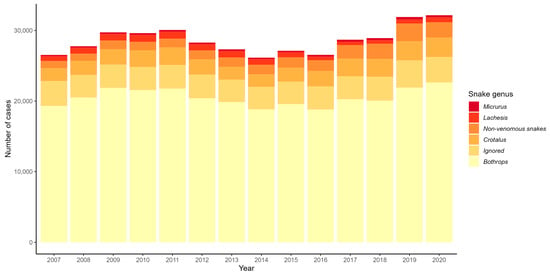
Figure 1.
The number of records in the dataset by type of snakebite reported in Brazil from 2007 to 2020. Bothrops envenomations were frequent in all years. In 2020, the highest number of total cases (32,160) was recorded; the lowest number of total cases during the 14 years was recorded in 2014. The high frequency of ignored snake envenomation cases is noteworthy.
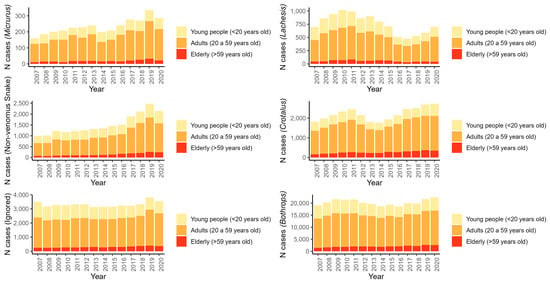
Figure 2.
The age structure of reported cases in this dataset, divided into three categories: young (up to 18 years of age), adults (aged between 20 and 59 years), and elderly (60 years and over).
Most cases were reported in the north and central west. As previously stated, most reports are from Bothrops and Lachesis genera (Figure 3).
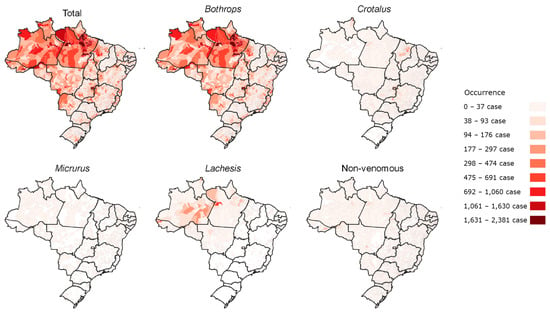
Figure 3.
The number of reported snakebite cases by snake genus and by municipality in Brazil. Color intensity is related to the frequency of cases. The northern region has the highest number of cases, mainly caused by Bothrops and Lachesis genera.
There is little change in severity over time. There are increasingly fewer reports of severe cases for Micrurus across the whole timeline; however, for Lachesis, Crotalus, and Bothrops, there is an increase in the proportion of severity over time (Figure 4). The most severe cases with bad prognoses can progress to death. In this regard, most of the deaths were caused by Bothrops, with an increase in frequency and proportion in the last two years (Figure 5).
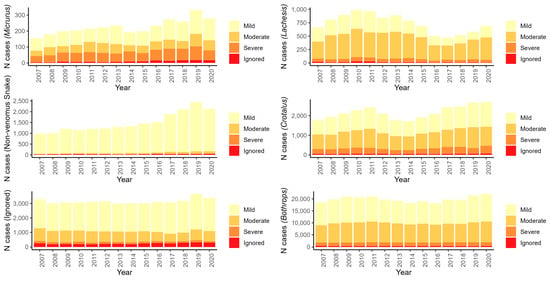
Figure 4.
The distribution of severity by type of snakebite. Non-venomous envenomations are classified as mild, although those from Micrurus have a higher proportion of severity. Lachesis and Cortalus cases are responsible for moderate cases. Bothrops are associated with cases with symptoms ranging between mild and moderate.
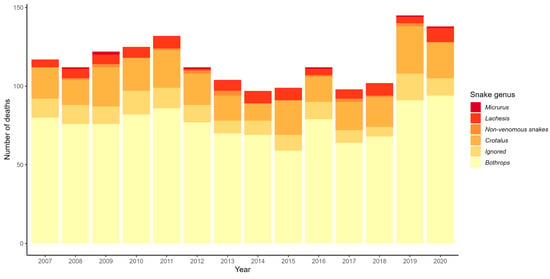
Figure 5.
The number of deaths from envenomations over the focal period. The highest and lowest frequencies of envenomations were reported in 2019 (145 deaths) and 2014 (97 deaths), respectively. The primary cause of death is envenomation by Bothrops sp.
3. Methods
The data were collected from the SINAN; original files are available at https://datasus.saude.gov.br/transferencia-de-arquivos/ in DBC format, a compressed version of DBF files, accessed on 23 September 2021.
To download the files, the following procedures were performed: (1) in the “Fonte” (source) option, “SINAN—Sistema de Informações de Agravos de Notificação” was selected; (2) in “Modalidade” (modality), the option “Dados” (data) was selected; (3) in “Tipo de Arquivo” (File type), the option “ANIM—Acidente por animais peçonhentos” (Venomous animals accidents) was chosen; (4) in “Ano” (year), the period from 2007 to 2020 was selected; and (5) in “UF” (acronym for Brazilian states), all the options were selected. The data sets obtained comprise 378 organized files (representing the 27 states and 14 years of study). No individually identifiable information is made available in the dataset.
All data processing was performed using the “R 4.3.2” language in its integrated development environment (IDE) “RStudio 2023.09.1-494” [15]. We imported and decompressed the datasets through the “read.dbc” library and then merged them into one single dataset using the “tidyverse” library, function “bind_row”. This resulted in a dataset with 2,422,825 records. After filtering for snakebites, a dataset of 400,848 was produced. This second dataset was processed to create labels and standardize the variables through the “Hmisc” library, resulting in the final database. For the graphics, the “ggplot2” library was used. The maps required the use of municipal and state boundaries provided by the “rgdal” library (Figure 6).
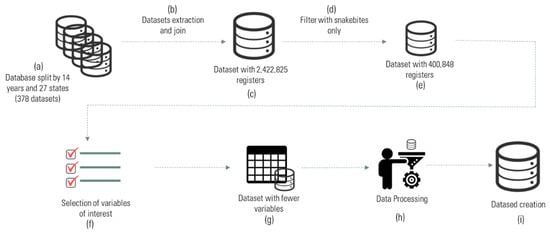
Figure 6.
The dataset processing steps. (a) Data gathering via the original database divided by years and states (378 datasets), (b) extraction and joining, (c) intermediate dataset (2,422,825 records), (d) filtering, (e) intermediate dataset (400,848 registers), (f) variable selection, (g) intermediate dataset (74 variables), (h) labeling, standardizing and final adjustments, and (i) final dataset.
For the risk factors analysis, the outcome considered was death due to snake envenomation. The variable “EVOLUCAO” was adjusted to exclude “Death from other causes” from the study. Additionally, all other fields filled with “unknown” were also transformed into NA values, thus allowing the right tests to be applied. The analysis was made with the R 4.3.2 environment in its IDE RStudio 2023.09.1-494 [15].
The SINAN undergoes constant changes related to system update processes, so it is important to provide a processed database. For this reason, we made the originals available on GitHub in a compressed folder called “ANIMAC.zip” [14]. Tables S1 and S2 describe each variable in the database according to the codebook provided by the Ministry of Health (https://portalsinan.saude.gov.br/acidente-por-animais-peconhentos, accessed on 8 January 2024). The information in Table S3 was made from the database processed using the “R_script_for_Silva-Neto_et.al.05.07.2022.zip” script [14]. Table S3 and the final dataset in CSV format, named “DATA_BASE.csv”, along with Table S4 containing the data analysis are also available on GitHub [14]. Previous publications corroborate these findings [16,17].
The variables removed from the raw dataset were:
- TP_ACIDENT—filtering for snakebites, only a single value remained.
- CLI_LOCA_1 and CLI_OUTR_3—open field variables that present (i) a lack of standard filling procedures, (ii) subjectivity in the filling, and (iii) the presence of special characters that can cause loss of records when exporting data to other formats.
- ANI_TIPO_1, ANI_ARANHA, and ANI_LAGART—removed due to the low percentage of completeness caused by the filter and the presence of records related to envenomation from sources other than snakes.
4. User Notes
Snakebites are responsible for significant social and economic impacts associated with sequelae and deaths [18,19]. In Brazil, between 2007 and 2020, 400,848 cases of snakebites were reported to SINAN across the country, a number considered relatively high when compared to other Latin American countries [20]. The wide distribution of snakes in Brazil is responsible for many snakebite cases [21]. To meet the needs of epidemiologists and health managers, we offer this dataset with a script in open “R” language that allows standardization for future studies generating evidence for decision-making in public health. Knowing the vulnerability to snakebites, information about clinics, treatment, and access to snakebite serum is essential for improving services and reducing morbidity and mortality.
Supplementary Materials
The following supporting information can be downloaded at: https://www.mdpi.com/article/10.3390/data9080091/s1, Table S1. Socio-demographic data (SINAN_2007_2020). Table S2. Clinical and Laboratory data–Symptoms (SINAN_2007_2020). Table S3. Descriptive table. Table S4. Analysis and Statistics.
Author Contributions
A.V.S.-N. was responsible for Data curation, Formal analysis, Software, Visualization, Writing—original draft; G.S.M., A.A.S.B., J.S.M.C. and P.C.S.B. were responsible for Data curation, Writing—review & editing; T.C.A.R. was responsible for Resources, Writing—review & editing; D.C.B.-d.-S. was responsible for Writing—original draft, Writing—review & editing; É.S.R. was responsible for Data curation, Writing—review & editing; P.T.E. was responsible for Conceptualization, Methodology, Supervision, Writing—review & editing; T.L. and W.M.M. were responsible for Conceptualization, Funding acquisition, Methodology, Supervision, Writing—review & editing; V.S.S. was responsible for Conceptualization, Funding acquisition, Methodology, Project administration, Supervision, Writing—original draft, Writing—review & editing. The manuscript was reviewed by all authors. All authors have read and agreed to the published version of the manuscript.
Funding
This study was funded by FAPEAM (PRODOC—Resolução Nº 003/2022, POSGRAD 2023/2024—Resolução 002/2023). W.M.M., P.T.E. and V.S.S. are supported by CNPq—PQ scholarship. A.V.S.-N. has a scholarship from CAPES; Brazilian Ministry of Health (proposal No. 733781/19-035).
Informed Consent Statement
Not applicable.
Data Availability Statement
All of the code to create the dataset is available on GitHub [15].
Acknowledgments
CEPCLAM research group and the data analysis laboratory LaBData Manaus.
Conflicts of Interest
The authors declare no conflicts of interest.
References
- Friedrich, M. Efforts to Address Snakebite. JAMA 2018, 320, 227. [Google Scholar] [CrossRef] [PubMed]
- The Lancet. Snake-bite envenoming: A priority neglected tropical disease. Lancet 2017, 390, 2. [Google Scholar] [CrossRef] [PubMed]
- Mohapatra, B.; Warrell, D.A.; Suraweera, W.; Bhatia, P.; Dhingra, N.; Jotkar, R.M.; Rodriguez, P.S.; Mishra, K.; Whitaker, R.; Jha, P.; et al. Snakebite mortality in India: A nationally representative mortality survey. PLoS Negl. Trop. Dis. 2011, 12, e1018. [Google Scholar] [CrossRef] [PubMed]
- Chippaux, J.P. Snakebite envenomation turns again into a neglected tropical disease! J. Venom. Anim. Toxins Trop. Dis. 2022, 23, 38. Available online: http://www.scielo.br/j/jvatitd/a/sxkGNpcwpLYmYPcMWY9hP5P/?lang=en (accessed on 13 June 2023). [CrossRef] [PubMed]
- Roriz, K.R.P.S.; Zaqueo, K.D.; Setubal, S.S.; Katsuragawa, T.H.; da Silva, R.R.; Fernandes, C.F.C.; Cardoso, L.A.P.; Rodrigues, M.M.d.S.; Soares, A.M.; Stábeli, R.G.; et al. Epidemiological study of snakebite cases in Brazilian Western Amazonia. Rev. Soc. Bras. Med. Trop. 2018, 51, 338–346. [Google Scholar] [CrossRef] [PubMed]
- Information System of Notifiable Diseases. SINANWEB-Dados Epidemiológicos Sinan. Available online: http://portalsinan.saude.gov.br/dados-epidemiologicos-sinan (accessed on 16 November 2023).
- Rocha, M.S.; Cavalcante, M.V.; Medeiros, F.C.D.; Codenotti, S.B.; Pelissari, D.M.; Andrade, K.B.; da Silva, G.D.M.; Arakaki-Sanchez, D.; Pinheiro, R.S. Sistema de Informação de Agravos de Notificação (Sinan): Principais características da notificação e da análise de dados relacionada à tuberculose. Epidemiol E Serviços Saúde 2020, 29, e2019017. [Google Scholar] [CrossRef] [PubMed]
- MINISTÉRIO DA SAÚDE. Guia de Vigilância Epidemiológica; MINISTÉRIO DA SAÚDE: Brasília, Brazil, 2005; pp. 17–34. [Google Scholar]
- MINISTÉRIO DA SAÚDE. Sistema De Informação De Agravos De Notificação-Sinan: Normas E Rotinas. Ms; Série a. Normas E Manuais Técnicos; MINISTÉRIO DA SAÚDE: Brasília, Brazil, 2007. [Google Scholar]
- Base Legislação da Presidência da República-Lei No 12.527 de 18 de Novembro de 2011. Available online: https://legislacao.presidencia.gov.br/atos/?tipo=LEI&numero=12527&ano=2011&ato=dc1UTUU1UMVpWT65a (accessed on 27 September 2023).
- Heukelbach, J.; André Chichava, O.; de Oliveira, A.R.; Häfner, K.; Walther, F.; de Alencar, C.H.; Ramos, A.N., Jr.; Ferreira, A.C.; Ariza, L. Interruption and defaulting of multidrug therapy against leprosy: Population-based study in Brazil’s Savannah region. PLoS Negl. Trop. Dis. 2011, 5, e1031. [Google Scholar] [CrossRef] [PubMed]
- De Queiroz, O.V.; de Guerra, A.A., Jr.; Machado, C.J.; Andrade, E.L.G.; Meira, W., Jr.; de Acúrcio, F.A.; dos Santos Filho, W.; Cherchiglia, M.L. A construção da Base Nacional de Dados em Terapia Renal Substitutiva (TRS) centrada no indivíduo: Relacionamento dos registros de óbitos pelo subsistema de Autorização de Procedimentos de Alta Complexidade (Apac/SIA/SUS) e pelo Sistema de Informações sobre Mortalidade (SIM)–Brasil, 2000–2004. Epidemiol. E Serviços Saúde 2009, 18, 107–120. [Google Scholar]
- Braga, J.U. Vigilância epidemiológica e o sistema de informação da tuberculose no Brasil, 2001–2003. Rev. Saúde Pública 2007, 41, 77–87. [Google Scholar] [CrossRef] [PubMed][Green Version]
- Silva-Neto, A.V.; Cordeiro, J.S.M.; Balieiro, A.A.d.S.; Sampaio, V.d.S. Description and Quality of the Snakebite Database in Brazil from 2007 to 2020. GitHub. Available online: https://github.com/LabdataManaus/describe_snakebite/tree/main (accessed on 25 September 2023).
- RStudio Team. RStudio: Integrated Development for R. 2022. Available online: http://www.rstudio.com/ (accessed on 30 September 2023).
- Magalhães, S.F.V.; Peixoto, H.M.; Moura, N.; Monteiro, W.M.; De Oliveira, M.R.F. Snakebite envenomation in the Brazilian Amazon: A descriptive study. Trans. R. Soc. Trop. Med. Hyg. 2019, 113, 143–151. [Google Scholar] [CrossRef] [PubMed]
- Chippaux, J.P. Epidemiology of envenomations by terrestrial venomous animals in Brazil based on case reporting: From obvious facts to contingencies. J. Venom. Anim. Toxins Trop. Dis. 2015, 21, 13. Available online: https://pubmed.ncbi.nlm.nih.gov/26042152/ (accessed on 2 April 2023). [CrossRef] [PubMed]
- Liblik, K.; Byun, J.; Saldarriaga, C.; Perez, G.E.; Lopez-Santi, R.; Wyss, F.Q.; Liprandi, A.S.; Martinez-Sellés, M.; Farina, J.M.; Mendoza, I.; et al. Snakebite Envenomation and Heart: Systematic Review. Curr. Probl. Cardiol. 2022, 47, 100861. [Google Scholar] [CrossRef] [PubMed]
- Suhita, R.; Begum, I.; Rashid, M.; Chandran, V.P.; Shastri, S.A.; Kantamneni, R.; Rajan, A.K.; Thunga, G. Systematic review and meta-analysis of global prevalence of neurotoxic and hemotoxic snakebite envenomation. East. Mediterr. Health J. 2022, 28, 909–916. [Google Scholar] [CrossRef] [PubMed]
- Lancet, T. Snakebite—emerging from the shadows of neglect. Lancet 2019, 393, 2175. [Google Scholar] [CrossRef] [PubMed]
- Schneider, M.C.; Min, K.-D.; Hamrick, P.N.; Montebello, L.R.; Ranieri, T.M.; Mardini, L.; Camara, V.M.; Luiz, R.R.; Liese, B.; Vuckovic, M.; et al. Overview of snakebite in brazil: Possible drivers and a tool for risk mapping. PLoS Negl. Trop. Dis. 2021, 15, e0009044. [Google Scholar] [CrossRef] [PubMed]
Disclaimer/Publisher’s Note: The statements, opinions and data contained in all publications are solely those of the individual author(s) and contributor(s) and not of MDPI and/or the editor(s). MDPI and/or the editor(s) disclaim responsibility for any injury to people or property resulting from any ideas, methods, instructions or products referred to in the content. |
© 2024 by the authors. Licensee MDPI, Basel, Switzerland. This article is an open access article distributed under the terms and conditions of the Creative Commons Attribution (CC BY) license (https://creativecommons.org/licenses/by/4.0/).